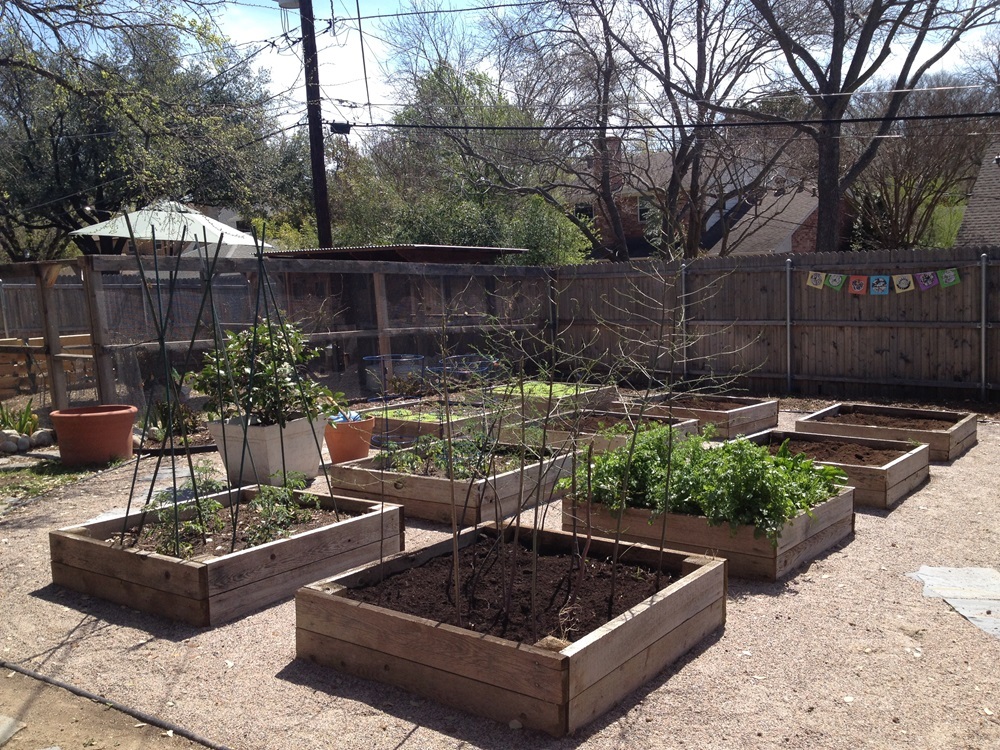Square Foot Gardening Soil Mix…Do I think it works for Texas?
April 20, 2010
What Works in Cooler Climates Doesn't Always Work in Texas!
Well, some parts of it...
I get a ton of questions about SFG (Square Foot Gardening) so I thought I'd go ahead and address it here. My opinion is No, you don't have to follow the principles to the letter to get the results you need, especially in our climate. Not to say that there aren't those who've have had success with the plan here.
I think that there are some good principles in the book that have obviously worked for the author in his particular experience. Specifically in learning how to rotate crops, spacing, etc., especially for beginner vegetable gardener.
However, In climates like those here in Texas, I do believe, from extensive experience, that you'll need to make some adjustments to the soil mix and the depth of the beds for best results. I just don't think the author has to garden in 107F degree heat!
Firstly, 6-inch deep beds are too shallow for my taste. Trying to keep your raised bed soil adequately watered is tough in the summer with that little soil volume. Especially considering that the organic matter is going to break down, leaving you with less than 6-inches worth of soil. Larger root systems, such as those of tomatoes, are going to need more soil volume. I build my beds to 12" tall.
I don't recommend tilling up the soil underneath your raised beds here, as you'll end up with lots of extra weed seed germination, Bermuda grass and nut sedge. So using newspaper and weed block fabric on top of the existing soil, without tilling it, is usually the easiest way to go. Watered cardboard works well too. But that means you're going to need a good 8"-10" of soil to best accommodate your plants.

PC: Leslie F. Halleck
More important is the soil mix. The SFG mix calls for a good amount of peat moss and vermiculite (The recipe is 1/3 blended compost, 1/3 peat moss, and 1/3 coarse vermiculite.) This can turn into a watering nightmare for you in the summer. Once peat dries it can be very difficult to rehydrate and you end up with a brick. You're much better off upping the levels of organic compost, humus, some high quality topsoil and expanded shale instead of the vermiculite. Throw in some greensand to help you retain moisture and provide micronutrients and some composted manure for a Nitrogen charge. If you want to use something with a peat moss-like texture, but without the hydration problems, go with COIR. A superior product in my experience (made from coconut husks).
Another thing...there is the impression in SFG that because you use compost in your beds that you don't have to use any fertilizer. Realize that compost is an organic amendment, which will eventually begin releasing nutrients slowly as it is decomposed by microbes (which will take a while to get going). Organic matter also breaks down faster in higher temps, so you'll have to replenish more quickly in hot climates. Also realize that what it will offer is mostly Nitrogen. It's not a complete "fertilizer" per say. You're still going to need to provide a good organic food to your plants, especially when first planted. Continual applications of compost will feed your plants as it breaks down, but don't expect a quick green up from it, and don't expect it to feed your plants enough if you don't have good microbial activity in the soil.
ADDENDUM: I realize there are folks on the SFG board who will tell you that you can't garden in the summer in Texas and that it's not our season, but they are wrong. They don't understand our climate and growing season, which is incredibly different even from areas just a couple of hours North of us. They also don't understand our soils. Please take my advice as a professional horticulturist on this one. We have a 12-month gardening season here and you can grow year-round, NOT just September-May. But they are correct on one point, you can't garden in the official SFG soil here in July, because it turns to rock and you can never keep it hydrated because of it's composition and shallow depth. For example, you have to plant your fall tomatoes here in July. Period. if you don't you will not have a fall tomato harvest. Also, you're not wasting growing soil by going to 10-12" here - it's necessary. Sure, you can grow winter crops, such as lettuce, broccoli, etc, here in more shallow containers, but not larger warm season crops. Once you get some experience under your belt, you'll see the difference. You can't successfully harvest year-round here in 6" of soil, not to mention 6" of soil that is heavy on peat moss.
Here is one of my discussions on good soil mixes for your Texas raised beds.

